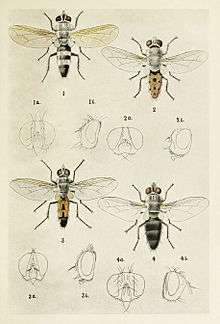Tachinidae
The Tachinidae are a large and variable family of true flies within the insect order Diptera, with more than 8,200 known species and many more to be discovered. Over 1300 species have been described in North America alone. Insects in this family commonly are called tachinid flies or simply tachinids. As far as is known, they all are protelean parasitoids, or occasionally parasites, of arthropods, usually other insects. The family is known from many habitats in all zoogeographical regions and is especially diverse in South America.[2]

| Tachinidae | |
|---|---|
| Tachina fera | |
| Scientific classification | |
| Kingdom: | Animalia |
| Phylum: | Arthropoda |
| Class: | Insecta |
| Order: | Diptera |
| (unranked): | Eremoneura |
| (unranked): | Cyclorrhapha |
| Section: | Schizophora |
| Subsection: | Calyptratae |
| Superfamily: | Oestroidea |
| Family: | Tachinidae Bigot, 1853[1] |
| Subfamilies | |
| Diversity | |
| 1,523 genera | |
Description

Tachinid flies are extremely varied in appearance. Some adult flies may be brilliantly colored and then resemble blow-flies (family Calliphoridae). Most however are rather drab, some resembling house flies. However, Tachinid flies commonly are more bristly and more robust. Also, they usually have a characteristic appearance. They have three-segmented antennae, a diagnostically prominent postscutellum bulging beneath the scutellum (a segment of the mesonotum). They are aristate flies, and the arista usually is bare, though sometimes plumose. The calypters (small flaps above the halteres) are usually very large. Their fourth long vein bends away sharply.
Adult flies feed on flowers and nectar from aphids and scale insects. As many species typically feed on pollen, they can be important pollinators of some plants, especially at higher elevations in mountains where bees are relatively few.
The taxonomy of this family presents many difficulties. It is largely based on morphological characters of the adult flies, but also on reproductive habits and on the immature stage.
As biological pest control
Tachinid flies also parasitize the Asian Corn Borer, a moth pest of maize commonly found in East Asia. This has allowed them to be used as biological control agents by farmers. Due to the lack of specificity in choosing hosts Tachinidae are considered generalist biological control agents.[11]
Evolution
This clade appears to have originated in the middle Eocene.[12] The oldest known fossil (Lithexorista) is known from the Eocene aged Green River Formation in Wyoming.[13][14]
See also
References
- Systema Dipterorum: Tachinidae
- James E. O'Hara; Shannon J. Henderson (December 18, 2018). "World Genera of the Tachinidae (Diptera) and Their Regional Occurrence" (PDF).
- Hastings, H.; Conling, D.E.; Graham, D.Y. (1988). "Notes on the natural host surveys and laboratory rearing of Goniozus natalensis Gordh (Hymenoptera: Bethylidae), a parasitoid of Eldana saccharina Walker (Lepidoptera: Pyralidae) larvae from Cyperus papyrus L. in Southern Africa" (PDF). Journal of the Entomological Society of Southern Africa. 51: 1.
- Morewood, W. Dean; Wood, D. Monty (2002). "Host utilization byExorista thula Wood (sp. nov.) and Chetogena gelida (Coquillett) (Diptera: Tachinidae), parasitoids of arctic Gynaephora species (Lepidoptera: Lymantriidae)". Polar Biology. 25 (8): 575–582. doi:10.1007/s00300-002-0382-y.
- "Parasitic Flies - Ontario AppleIPM". www.omafra.gov.on.ca.
- Imms' General Textbook of Entomology: Volume 1: Structure, Physiology and Development Volume 2: Classification and Biology. Berlin: Springer. 1977. ISBN 978-0-412-61390-6.
- Wood, D. M. 1987. Chapter 110. Tachinidae. Pp. 1193-1269 in McAlpine, J.F., Peterson, B.V., Shewell, G.E., Teskey, H.J., Vockeroth, J.R. and D.M. Wood (eds.), Manual of Nearctic Diptera. Volume 2. Agriculture Canada Monograph 28: i-vi, 675-1332.
- Edmunds, Malcolm (1976-03-01). "Larval mortality and population regulation in the butterfly Danaus chrysippus in Ghana". Zoological Journal of the Linnean Society. 58 (2): 129–145. doi:10.1111/j.1096-3642.1976.tb00823.x. ISSN 0024-4082.
- Brubaker, R. W. (1968-02-01). "Seasonal Occurrence of Voria ruralis a Parasite of the Cabbage Looper, in Arizona, and Its Behavior and Development in Laboratory Culture1". Journal of Economic Entomology. 61 (1): 306–309. doi:10.1093/jee/61.1.306. ISSN 0022-0493.
- entomology.Wisconsin.edu. Compsilura concinnata, Parasitoid of Gypsy Moth
- Grenier, S. (1988-04-01). "Applied biological control with Tachinid flies (Diptera, Tachinidae): A review". Anzeiger für Schädlingskunde, Pflanzenschutz, Umweltschutz. 61 (3): 49–56. doi:10.1007/BF01906254. ISSN 0340-7330.
- Zhao, Zhe; Su, Tian-Juan; Chesters, Douglas; Wang, Shi-di; Ho, Simon Y. W.; Zhu, Chao-Dong; Chen, Xiao-lin; Zhang, Chun-Tian (2013). "The Mitochondrial Genome of Elodia flavipalpis Aldrich (Diptera: Tachinidae) and the Evolutionary Timescale of Tachinid Flies". PLOS ONE. 8 (4): e61814. Bibcode:2013PLoSO...861814Z. doi:10.1371/journal.pone.0061814. PMC 3634017. PMID 23626734.
- C. H. T. Townsend. 1921. Some new muscoid genera ancient and recent. Insectur Inscitiae Menstruus 9:132-134
- N. L. Evenhuis. 1994. Catalogue of the Fossil Flies of the World (Insecta: Diptera) 1-600
External links
| Wikimedia Commons has media related to Tachinidae. |
- Australasian/Oceanian Diptera Catalog
- British Insects: the Families of Diptera
- Bugguide.net: North American Tachinidae
- Diptera.info
- Diptera: Tachinidae - ENY 3005 Family Identification
- Handbooks for the Identification of British Insects, Vol. X. Part 4(a): Diptera Cyclorrhapha – Calyptrata (I) Section (a). Tachinidae and Calliphoridae (1st portion) (2nd portion), by F.I. van Emden (1954), Royal Entomological Society of London
- Key to the genera of Tachinidae in the eastern US
- NADS Homepage for Tachinidae Resources
- Rhinophorids - when a tachinid isn't a tachinid!
- TachImage Gallery
- Tachinid Flies - Family Tachinidae, diagnostic photographs of 8 species by Cirrus Digital Imaging
- Tachinid Morphology J. E. O'Hara, North American Dipterists Society
- The Siphonini (Diptera: Tachinidae) of Europe (preview), by Stig Andersen (1996)
- UK Tachinid Recording Scheme
- Stireman, J. TACHINIDAE: Evolution, Behavior, and Ecology